Synergism between calcium and cyclic GMP in cyclic AMP response element-dependent transcriptional regulation requires cooperation between CREB and C/EBP-beta
- PMID: 12773552
- PMCID: PMC156132
- DOI: 10.1128/MCB.23.12.4066-4082.2003
Synergism between calcium and cyclic GMP in cyclic AMP response element-dependent transcriptional regulation requires cooperation between CREB and C/EBP-beta
Abstract
Calcium induces transcriptional activation of the fos promoter by activation of the cyclic AMP response element (CRE)-binding protein (CREB), and in some cells its effect is enhanced synergistically by cyclic GMP (cGMP) through an unknown mechanism. We observed calcium-cGMP synergism in neuronal and osteogenic cells which express type II cGMP-dependent protein kinase (G-kinase); the effect on the fos promoter was mediated by the CRE and proportional to G-kinase activity. Dominant negative transcription factors showed involvement of CREB- and C/EBP-related proteins but not of AP-1. Expression of C/EBP-beta but not C/EBP-alpha or -delta enhanced the effects of calcium and cGMP on a CRE-dependent reporter gene. The transactivation potential of full-length CREB fused to the DNA-binding domain of Gal4 was increased synergistically by calcium and cGMP, and overexpression of C/EBP-beta enhanced the effect, while a dominant negative C/EBP inhibited it. With a mammalian two-hybrid system, coimmunoprecipitation experiments, and in vitro binding studies, we demonstrated that C/EBP-beta and CREB interacted directly; this interaction involved the C terminus of C/EBP-beta but occurred independently of CREB's leucine zipper domain. CREB Ser(133) phosphorylation was stimulated by calcium but not by cGMP; in cGMP-treated cells, (32)PO(4) incorporation into C/EBP-beta was decreased and C/EBP-beta/CRE complexes were increased, suggesting regulation of C/EBP-beta functions by G-kinase-dependent dephosphorylation. C/EBP-beta and CREB associated with the fos promoter in intact cells, and the amount of promoter-associated C/EBP-beta was increased by calcium and cGMP. We conclude that calcium and cGMP transcriptional synergism requires cooperation of CREB and C/EBP-beta, with calcium and cGMP modulating the phosphorylation states of CREB and C/EBP-beta, respectively.
Figures
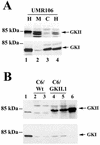

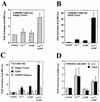
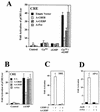
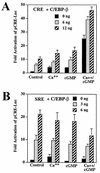


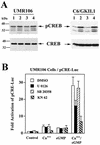



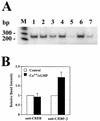
Similar articles
-
Role of basic region leucine zipper transcription factors cyclic AMP response element binding protein (CREB), CREB2, activating transcription factor 2 and CAAT/enhancer binding protein alpha in cyclic AMP response element-mediated transcription.J Neurochem. 2005 Jan;92(2):321-36. doi: 10.1111/j.1471-4159.2004.02882.x. J Neurochem. 2005. PMID: 15663480
-
Cooperative regulation of endogenous cAMP-response element binding protein and CCAAT/enhancer-binding protein beta in GH-stimulated c-fos expression.J Endocrinol. 2008 Jan;196(1):89-100. doi: 10.1677/JOE-07-0169. J Endocrinol. 2008. PMID: 18180320
-
Impaired cyclic AMP-dependent phosphorylation renders CREB a repressor of C/EBP-induced transcription of the somatostatin gene in an insulinoma cell line.Mol Cell Biol. 1995 Jan;15(1):415-24. doi: 10.1128/MCB.15.1.415. Mol Cell Biol. 1995. PMID: 7799950 Free PMC article.
-
Regulation of somatostatin gene transcription by cyclic adenosine monophosphate.Metabolism. 1996 Aug;45(8 Suppl 1):4-7. doi: 10.1016/s0026-0495(96)90068-2. Metabolism. 1996. PMID: 8769368 Review.
-
The Pleiotropic Face of CREB Family Transcription Factors.Mol Cells. 2023 Jul 31;46(7):399-413. doi: 10.14348/molcells.2023.2193. Epub 2023 Apr 4. Mol Cells. 2023. PMID: 37013623 Free PMC article. Review.
Cited by
-
CRE-mediated transcription and COX-2 expression in the pilocarpine model of status epilepticus.Neurobiol Dis. 2007 Jan;25(1):80-91. doi: 10.1016/j.nbd.2006.08.015. Epub 2006 Oct 9. Neurobiol Dis. 2007. PMID: 17029965 Free PMC article.
-
Sildenafil for the Treatment of Alzheimer's Disease: A Systematic Review.J Alzheimers Dis Rep. 2020 Apr 22;4(1):91-106. doi: 10.3233/ADR-200166. J Alzheimers Dis Rep. 2020. PMID: 32467879 Free PMC article. Review.
-
Immediate activation of chemosensory neuron gene expression by bacterial metabolites is selectively induced by distinct cyclic GMP-dependent pathways in Caenorhabditis elegans.PLoS Genet. 2020 Aug 10;16(8):e1008505. doi: 10.1371/journal.pgen.1008505. eCollection 2020 Aug. PLoS Genet. 2020. PMID: 32776934 Free PMC article.
-
Identification of the principal transcriptional regulators for low-fat and high-fat meal responsive genes in small intestine.Nutr Metab (Lond). 2017 Oct 23;14:66. doi: 10.1186/s12986-017-0221-3. eCollection 2017. Nutr Metab (Lond). 2017. PMID: 29075307 Free PMC article.
-
CCAAT/enhancer binding protein β in relation to ER stress, inflammation, and metabolic disturbances.Biomed Res Int. 2015;2015:324815. doi: 10.1155/2015/324815. Epub 2015 Jan 28. Biomed Res Int. 2015. PMID: 25699273 Free PMC article. Review.
References
-
- Aguirre, J., L. Buttery, M. O'Shaughnessy, F. Afzal, I. F. de Marticorena, M. Hukkanen, P. Huang, I. Maclntyre, and J. Polak. 2001. Endothelial nitric oxide synthase gene-deficient mice demonstrate marked retardation in postnatal bone formation, reduced bone volume, and defects in osteoblast maturation and activity. Am. J. Pathol. 158:247-257. - PMC - PubMed
-
- Belsham, D. D., and P. L. Mellon. 2000. Transcription factors Oct-1 and C/EBPβ (CCAAT/enhancer-binding protein β) are involved in the glutamate/nitric oxide/cyclic-guanosine 5′-monophosphate-mediated repression of gonadotropin-releasing hormone gene expression. Mol. Endocrinol. 14:212-228. - PubMed
Publication types
MeSH terms
Substances
Grants and funding
LinkOut - more resources
Full Text Sources
Other Literature Sources
Molecular Biology Databases
